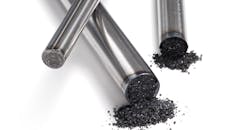Advancing Magnesium Treatment from Pour-Over Method for Ductile Iron
Q: When we produce ductile iron, we treat the ductile base iron during furnace tapping using the pour-over method: This is less than ideal for our large treatment size, and it results in excessive alloy additions (>1.5% addition rate). Additionally, we struggle with inconsistent magnesium recoveries, excessive slag and dross, and significant temperature loss. Plus, our foundry fills up with the effluent (i.e., smoke) directly following treatment. Can anything help us address all this?
A: The pour-over practice is a relatively simple method for producing ductile iron. First, the treatment alloy is weighed, and then placed in the bottom of the treatment ladle. The amount of alloy needed is calculated according to the anticipated treatment weight, base sulfur level, anticipated recovery and desired residual magnesium. Then, the metal is tapped from the furnace directly into this open top ladle.
This simple method of treating ductile iron has proven successful. Yet, there are several disadvantages to this method. Varying sulfur levels, for instance, make a difference in how much treatment alloy must be used to treat the iron. Increasing the amount of treatment alloy will result in additional silicon pick-up and lead to more slag and dross. Speed and accuracy also matter. At what speed is the furnace being tapped? Also, how accurate is your furnace operator at tapping the proper amount of iron? Lastly, as stated in your question, there is the issue of effluent (i.e. smoke). This method of treating the iron at the furnace tap makes it difficult to adequately capture the subsequent effluent.
Treating ductile iron with the cored wire practice solves all of these problems, and provides some additional benefits. The cored wire method for treating ductile iron is a proven technology that is gaining acceptance in foundries across the globe. The alloys (magnesium, FeSi, rare earths, calcium, etc.) are encased in a steel sheathing then delivered to the foundry in an easy to use cage.
Application is likewise simple, efficient and accurate. Using a highly automated system, the cored wire is injected into an already full ladle. The cored wire process will eliminate all your stated problems, while greatly improving the quality of your ductile iron.
Now, let’s go deeper into this issue. How can cored wire solve your specific problems while simultaneously improving your ductile iron? Since cored wire is produced with a high percentage of magnesium ( ~30%), the treatment alloy addition rates are significantly lower than traditional MgFeSi practices (pour-over, tundish, sandwich, etc.) Normal alloy addition rates associated with cored wire are as low as 0.4%. This lower addition rate has several benefits: lower silicon addition, lower temperature loss during treatment and cleaner, more fluid ductile iron.
From a process stand point, cored wire offers advantages the other methodologies do not. The treatment, for example, takes place after furnace tapping, thereby eliminating worries about tap time and accurate tap weights.
In addition, cored-wire treatment takes place in a specially designed treatment station that captures all the effluent from the treatment practice. This treatment station can be located anywhere in your foundry, eliminating the need to transport treated ductile iron long distances.
Ultimately, cored wire appears to be your answer. Moving forward, ASK Chemicals Metallurgical experts can provide a feasibility study that will include treatment station options, capital investment cost, treatment cost, and recommendations for a cored wire specifically designed to meet your foundry requirements, ensuring you’ll receive maximum value from this technology.
The INFORM™ cored wire is offered in a variety of compositions to accommodate a foundry’s unique base chemistry and casting section thickness. Furthermore, ASK offers cored wire in several sizes (9 mm / 13 mm / 16 mm) permitting treatment of small ladles (1,000 lbs.) and large ladles (+50,000 lbs.)
Join the Conversation. Email Your Questions for ASK Chemicals Share your insights, opinions, and elaborate on the questions and the experts' answer(s). You must be logged in to the website in order to post your comments.
